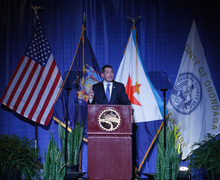Cheung: Transatlantic flights cannot fit Ryanair’s cost cutting strategy
The seat belt sign has been turned on and passengers should return to their seats. It’s been a bumpy ride this week for Irish low-cost airline Ryanair.
Last Monday, the company excited transatlantic travelers by announcing $10 flights from Europe to the United States. Sound too good to be true? Apparently Ryanair seemed to think so too and, in a bizarre move, turned the plane around and said it had made a mistake and no such flights were in the works.
And maybe it’s better off that way. Cheap transatlantic flights would have likely spelled disaster for Ryanair.
Several other airlines have attempted budget routes before, with the most recent effort coming from Oslo-based, Norwegian Air Shuttle. It offers flights to about six American cities from Copenhagen, Stockholm, and Gatwick with one-way fares just under $250. That’s about $200 to $300 cheaper than flights from Virgin Atlantic or British Airways, depending on the time of the year and route being travelled.
Since launching its service, Norwegian has swung into the red, losing about $120 million on the project. That’s because the transatlantic route comes with tough business needs. Long haul flights require more fuel and consequently larger planes. Longer routes also limit the number of flights that can booked in a day.
But the biggest challenge with flying over the Atlantic is passenger needs, which is coincidentally Ryanair’s biggest problem. Flying from New York to London takes over seven hours, which is a long time to ask passengers to sit in cramped, budget seats. Starting overseas routes would force Ryanair to include business and premium economy sections for travelers wanting more from their flights. But if the company still wants to stick to its one class fits all model, it should at least make the economy seats larger.
These are huge obstacles for Europe’s largest discount airline in terms of number of passengers, which offers fares from London to Oslo for $12.76. The airline’s model keeps ticket prices low by charging for literally everything else. Paying by credit card costs $5 extra. Overweight bags cost $22 extra per kilogram.
Ryanair’s eccentric and loose-lipped CEO Michael O’Leary once famously said passengers who forget to print out their boarding pass before arriving at the airport “should pay €60 for being so stupid.” That cost is now €70, by the way.
These are the cost cutting measures that might allow Ryanair to sell transatlantic flights for $10, but they would be an enormously unwelcome strategy for a long-haul flight where comfort becomes more important. Passengers flying so far would want a meal, have larger bags to check and require more legroom. If the company sticks to its current pricing model for flights from New York to London, it will have to convince passengers that saving money is of paramount priority over being comfortable for seven plus hours. All of those firm-specific problems will stack on top of the existing industry costs that Norwegian is already learning the hard way on its discount transatlantic flights.
Ryanair released a one-sentence statement Friday saying the company “has not considered or approved any transatlantic project and does not intend to do so.” But O’Leary and the company have long made public their interest in starting the service, which means the ambition is either still very much alive or an elaborate public relations stunt.
If, or perhaps when, Ryanair fuels another round of interest in transatlantic flights, there’s work to be done to make it profitable. Mr. O’Leary might want to follow his own advice, as once tweeted to a Ryanair employee: “get back to work you slacker or you’re fired.”
Brian Cheung is a senior broadcast and digital journalism and finance dual major. His column appears weekly. He can be reached at bkcheung@syr.edu and followed on Twitter @bcheungz.
Published on March 22, 2015 at 10:30 am





